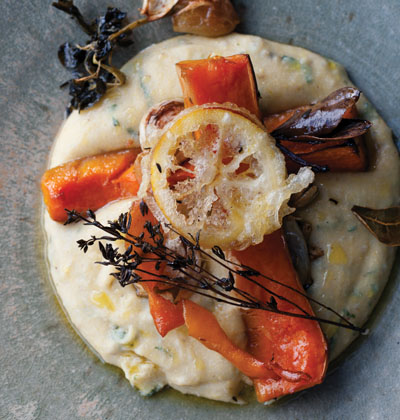Yotam Ottolenghi, a Jerusalem-born, London-based chef and writer, passed through Chicago on tour with his cookbook Plenty More. We asked him about the book.
Plenty More is all about vegetables, as was your first cookbook, Plenty. But your restaurants are not vegetarian. How did this come about?
Growing up in Jerusalem and Israel, there were always a great deal of vegetables around. I always enjoyed them. I was approached by The Guardian to write a vegetarian column for them. [Plenty More] represents the work that I have done for The Guardian over the years.
How is the book organized?
Not by vegetable, but by method of cooking. [The chapters are “Tossed,” “Steamed,” “Blanched,” “Simmered,” “Braised,” “Grilled,” “Roasted,” “Fried,” “Mashed,” “Cracked”—all of which contain eggs—“Baked,” “Sweetened.”] It’s interesting to show readers that the way in which we prepare veggies is crucial to results. People are not always aware that you can get very different things by applying various techniques. If you roast or fry or steam or serve a cauliflower raw, you get very different results.
The pictures are gorgeous, very rustic and appealing, but many of the recipes look long and daunting.
I planned them with home cooks in mind.
I also noticed that you don’t give specific preparation times with the recipes.
[The recipes are] not technically complicated. People take different times to cook things, so I would never estimate the time. Cooks know what they are getting into.
Some of these recipes’ ingredients I love but don’t use that often, like pomegranates, tahini, and Angostura bitters, and some I don’t even know how to find, like Cretan dakos, umeboshi purée, or kecap manis.
Quite a few ingredients are new and different, and I encourage people to go and seek them and look out for them. Kind of a mixture of new and old.
What do you think about chefs being celebrities?
It’s a question of fashion. Who celebrities are changes all the time. Current chefs are doing some very interesting things with food. That’s where people’s interest should be.
Interested in testing out one of Ottolenghi's creations? We snagged a recipe from Plenty More for butternut squash with buckwheat polenta.
Butternut Squash with Buckwheat Polenta and Tempura Lemon

Butternut Squash
1 large butternut squash (1.3 kg)
3 tbsp olive oil
1½ tbsp/25 g unsalted butter, diced
1¼ cups/300 ml vegetable stock
3 oregano sprigs (1/3 oz/10 g)
15 black peppercorns
8 allspice berries
6 cardamom pods, crushed
6 bay leaves
6 thyme sprigs
rind of 1 large orange shaved in long, narrow strips
8 cloves garlic, lightly cracked with the skin on
salt
Polenta
3 tbsp/30 g roasted buckwheat (kasha) or buckwheat groats
2/3 cup/150 ml whole milk
3¾ cups/900 ml vegetable stock
1/3 cup/10 g oregano leaves, coarsely chopped
1 bay leaf
1 tbsp thyme leaves
Shaved rind of ½ lemon
¾ cup/120 g polenta
¼ cup/60 g unsalted butter
salt and white pepper
Tempura lemon
4½ tbsp/35 g flour
3 tbsp plus 1 tsp/25 g cornstarch
5 tbsp/75 ml cold soda water
sunflower oil, for frying
1 lemon, cut crosswise into 1/8-inch -/3-mm-thick slices
salt
Preheat the oven to 400ºF. Trim the top and bottom off the butternut and halve lengthwise. Scoop out and discard the seeds and cut each half into 3 long wedges, skin on. Place the wedges in a large roasting pan with all the remaining squash ingredients and ¾ teaspoon salt, coating the butternut well with the aromatics. Bake for 50 minutes, turning the butternut pieces every 10 minutes or so and spooning the juices over them, until the squash is cooked, golden brown, and starting to crisp on top. Add a little stock during cooking if the pan is drying out.
Meanwhile, to make the polenta, put the kasha in a small baking pan and toast in the oven at the same time as the squash for 5 minutes, or 10 minutes for plain groats. Remove and crush lightly with a pestle and mortar.
In a large saucepan over high heat, combine the milk, stock, herbs, lemon rind strips, ¾ teaspoon salt, and a pinch of white pepper. Bring to a boil and then turn the heat to low and whisk in the polenta and buckwheat. Using a wooden spoon, stir every few minutes for 35 to 40 minutes, until the polenta is thick and cooked. If it is getting too thick, add a little water. At the end of the cooking, stir in the butter. The polenta should be thick but runny enough to fall off the spoon easily. Cover the top of the polenta with plastic wrap to stop a skin from forming and leave somewhere warm.
To make the tempura, mix together the flour and cornstarch, then whisk in the soda water until the mixture is smooth and runny. Sit the bowl over ice for 45 minutes.
Pour oil to a depth of 1¼ inches into a saucepan and heat to about 320ºF. Dip the lemon slices into the batter and fry for 2 to 3 minutes, until golden and crispy. Remove with a slotted spoon and sprinkle immediately with salt. Place a spoonful of warm polenta on each plate and lay a squash wedge across it, adding a mix of the baked aromatics on top. Finish with a tempura lemon slice and serve at once.



